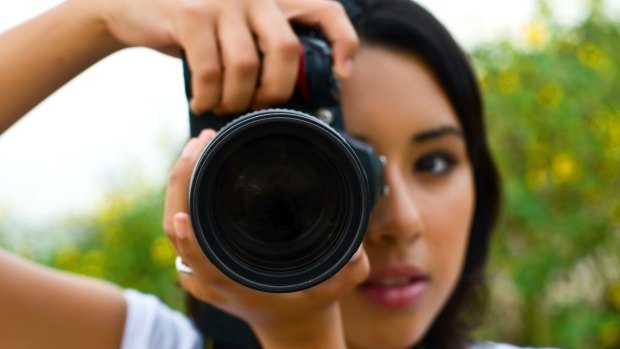This was published 9 years ago
What sort of camera to take on your holiday: tips

If you want the best quality, you need to go big with an SLR camera.Credit: iStock
Which camera should you take on your travels? There's no single answer that works for every traveller every time. Where you're going, what you want to photograph and what you want to do with the images are just some of the factors that feed into the answer. If you're wondering what might work for you, here's a primer.
For the boulevards
Unless you're trapped in the digital dark age, you've got a camera in your phone. If it's less than about five years old, or better still a smartphone, it's ideal if you're spending a week or two exploring New York City or Paris and looking for happy snaps. A close-up of your breakfast bagel, a selfie on top of the Eiffel Tower, the bright lights of Times Square and probably even video of the Elysee Palace guards – all easily accomplished. If sharing images on social media is a priority, a smartphone is ideal. You can also take advantage of smartphone apps that extend your camera's natural abilities, offering performance-enhancing treatments to your images. These include high dynamic range (HDR) apps that take multiple images and staple together the best bits from each.
It's not a tool for all seasons, and there are times when your phone's onboard camera just doesn't cut it. A smartphone gives you only limited control over exposure and focus, and wide-angle shots are out of the question, although clip-on lenses offer a workaround. The screen can be hard to see in bright sunlight but even with these limitations these are powerful imaging tools.
Want more image quality? Take a look at the slimline point-and-shoot pocket pals, with lenses that retract into the camera body. Small, light and easy to use, they combine portability with fabulous image quality, zoom lenses and in some cases Wi-Fi, allowing you to download images to a phone or tablet, all at a reasonable price. They're designed to do all the thinking for you, but nine times out of 10 you'll get a class result.
For the views
You're off to Bali and looking to capture the sunset on Kuta Beach, or on a road trip through America's West with the Grand Canyon in the frame. Consider a mirrorless camera. These dispense with the mirror and optical viewfinder to create a feature-rich compact camera with manual overrides as well as fully automatic functions, capable of producing high quality images. They're ideal for photo enthusiasts who want versatility without weight and bulk.
Many of these cameras come with an Advanced Photo System (APS) sensor, the same as those used in many single lens reflex (SLR) cameras. The payoff from a camera with a large sensor is image quality. Upsizing an image to fill a screen or make a large print requires less magnification if it was created on a big sensor rather than a small one, and therefore offers the possibility of superior quality.
Mirrorless cameras can be teamed with interchangeable lenses that expand your creative horizons, rivalling the performance of an SLR camera at a lower price.
Into the deep
Got a holiday that involves coral reefs, surf or sea kayaking coming up? There are now several waterproof point-and-shoot digital cameras that you can take out snorkelling or even on a shallow dive, starting from just a couple of hundred dollars. Most of the cost of producing these cameras goes into toughening and waterproofing, at the expense of image quality. You'll get better results if you tuck a not-so-tough camera inside a waterproof case, sold by some camera makers as well as third-party manufacturers. If that's your intention, look at what waterproof housings are available before you choose your camera.
Going big
Heading off to photograph bears in Alaska or feluccas on the Nile? For the traveller who wants ultimate quality from their image making, the choice is an SLR camera. Offering total control over the image-making process, SLRs are incredibly versatile. Plug in a fish-eye lens for extreme wide angle shots, or a telephoto to capture a hummingbird in the cloud forests of Ecuador. Add a GPS device and you can geotag your images to fix the exact shooting location, or fit your SLR with an underwater housing to capture the wonders of the deep.
SLRs broadly divide into two categories, those with an APS sensor and those with a full-frame 35mm sensor. The full-frame versions are bigger, heavier, more expensive and they require costlier lenses to exploit their full potential but in skilled hands, nothing beats them. These are the cameras used by photographers shooting for National Geographic and glossy fashion magazines.
Do you need this much quality? An SLR camera with an APS-sensor is quite capable of producing images for the cover of the weekend print edition of Traveller, or even to hang on a gallery wall.
As well as expense, SLR cameras come with a substantial downside in the form of weight. You're going to need a couple of zoom lenses at the very least. If you want to photograph wildlife or surfing events, add a long telephoto to your shopping list. Lugging an SLR camera and lenses around on a city walking tour will not enhance your day, guaranteed, but writing as one who does, I know I'd regret it if my gear stayed in my hotel rom.
Sign up for the Traveller Deals newsletter
Get exclusive travel deals delivered straight to your inbox. Sign up now.